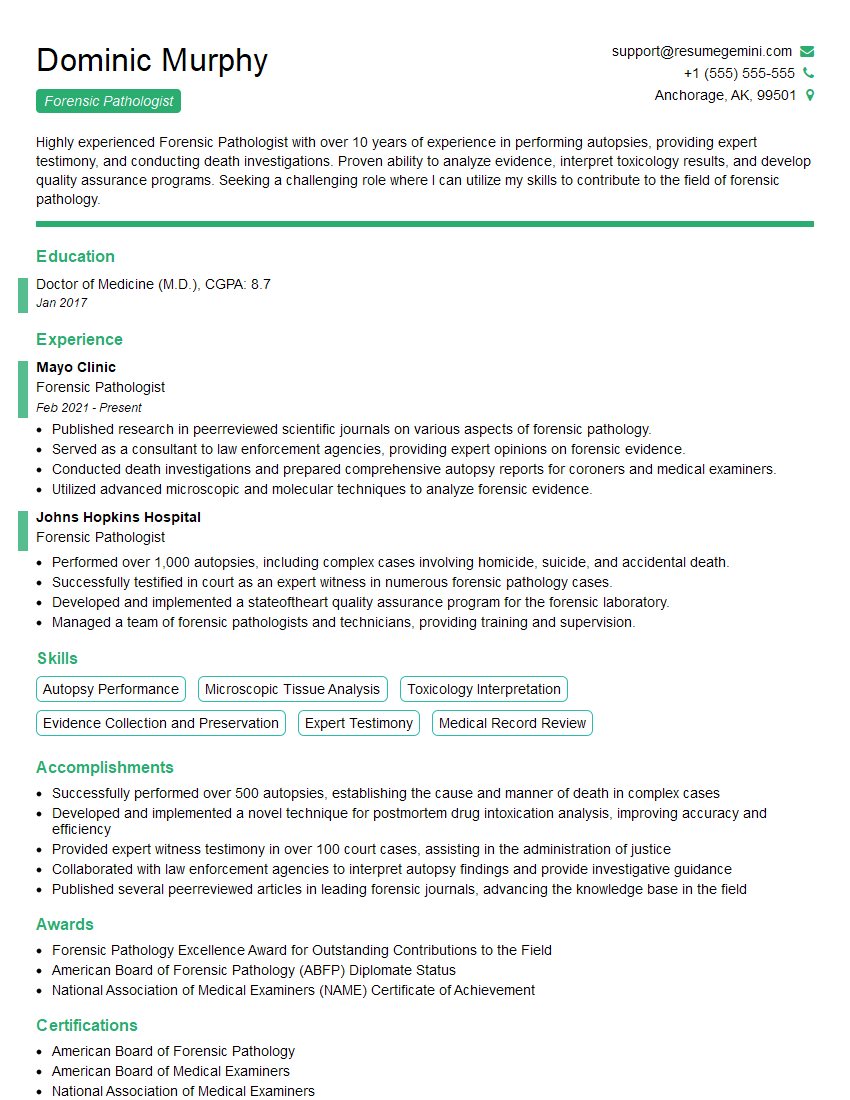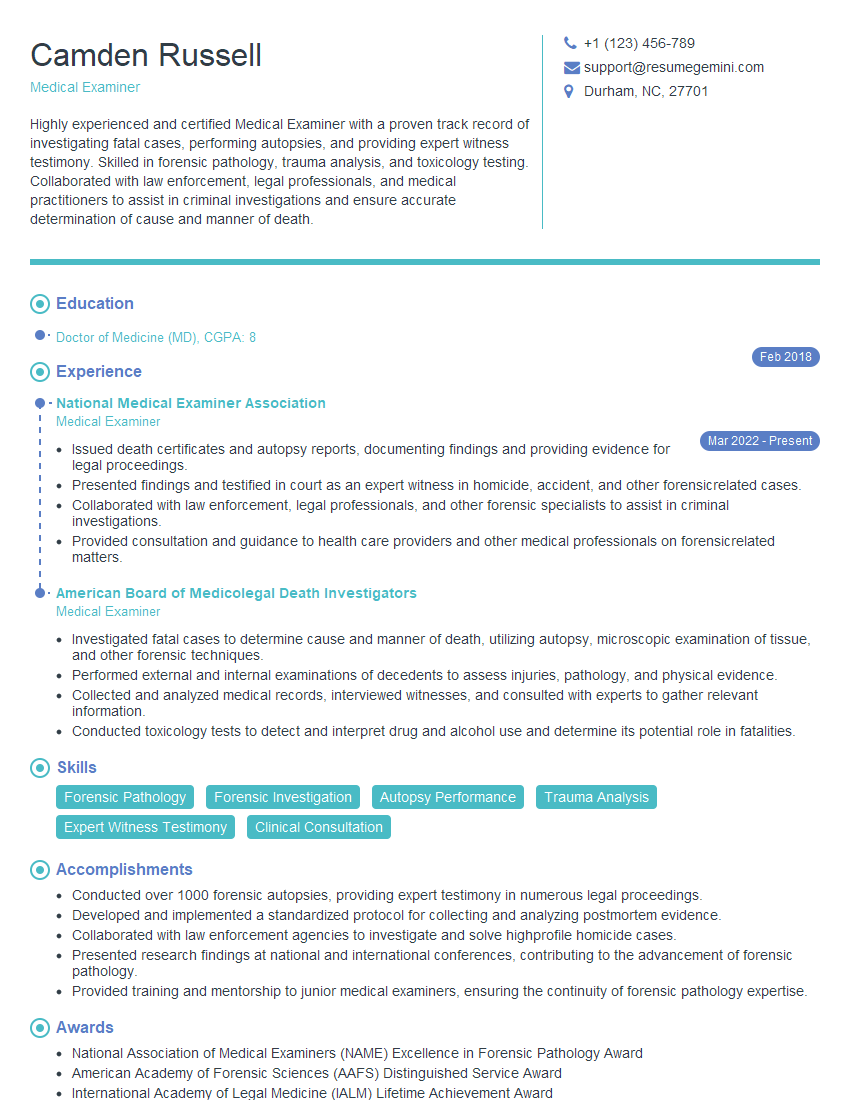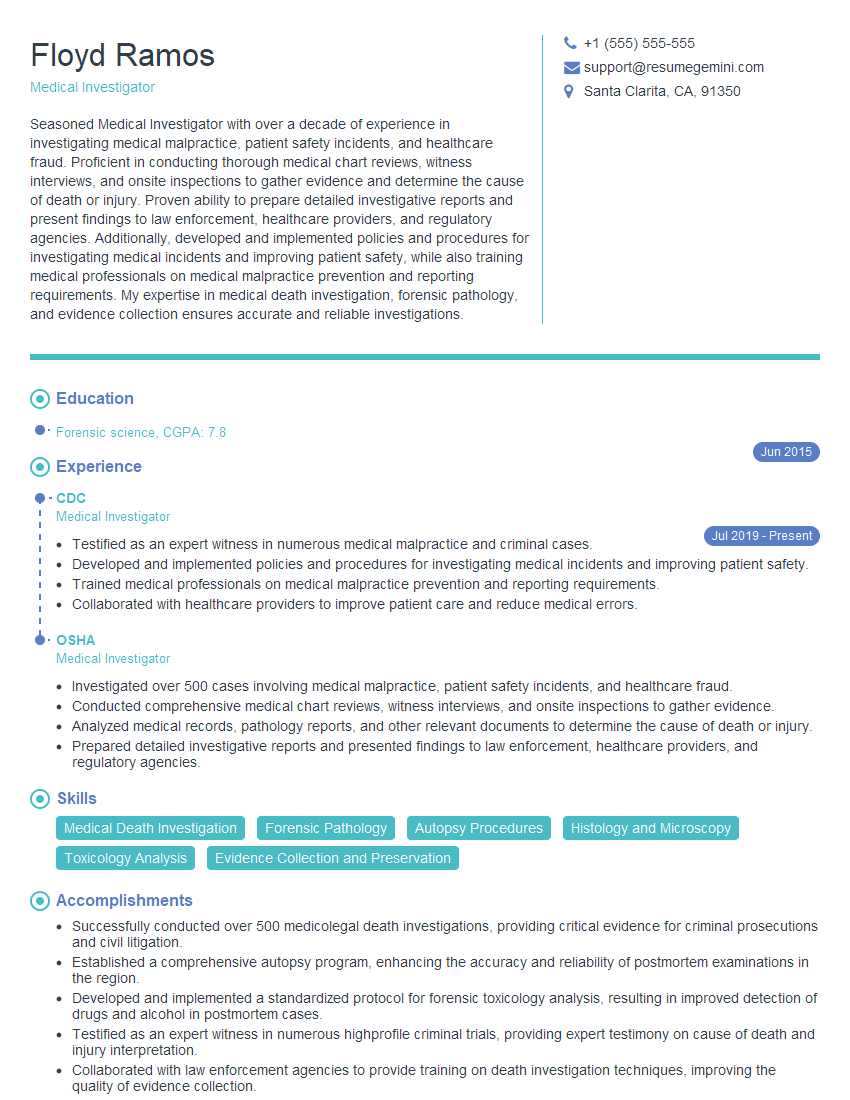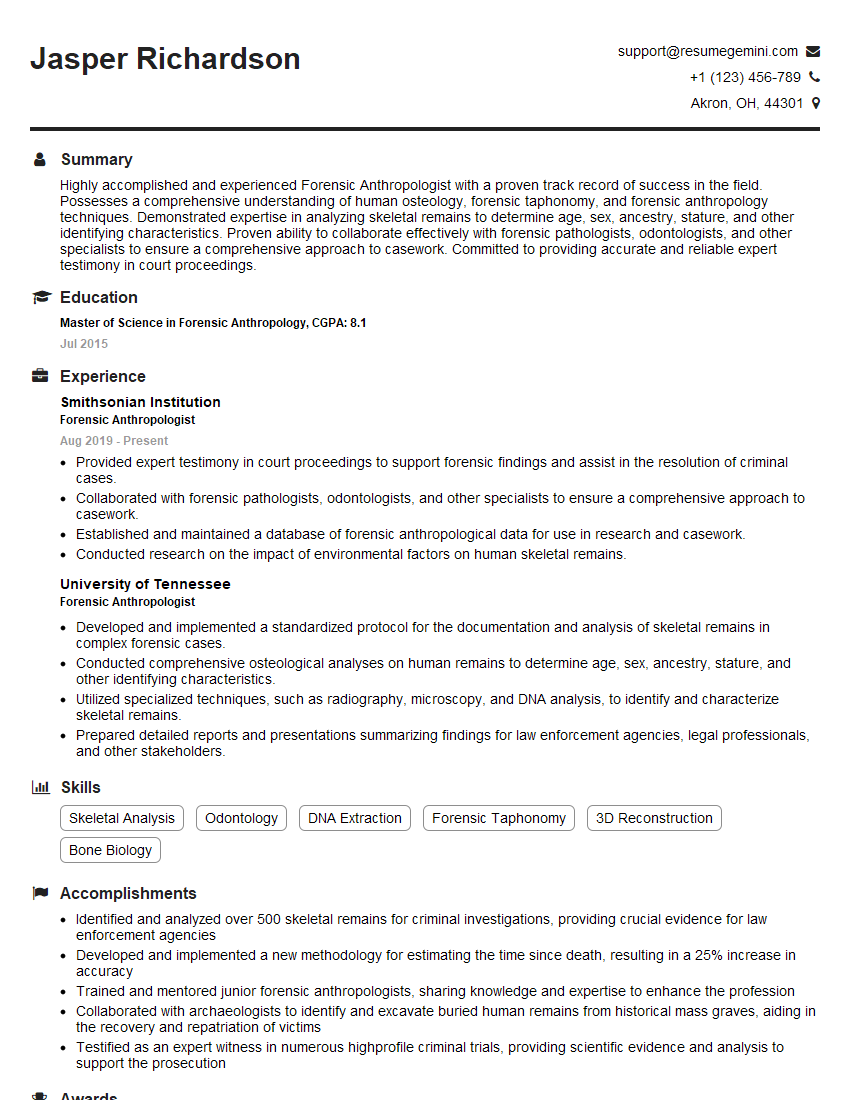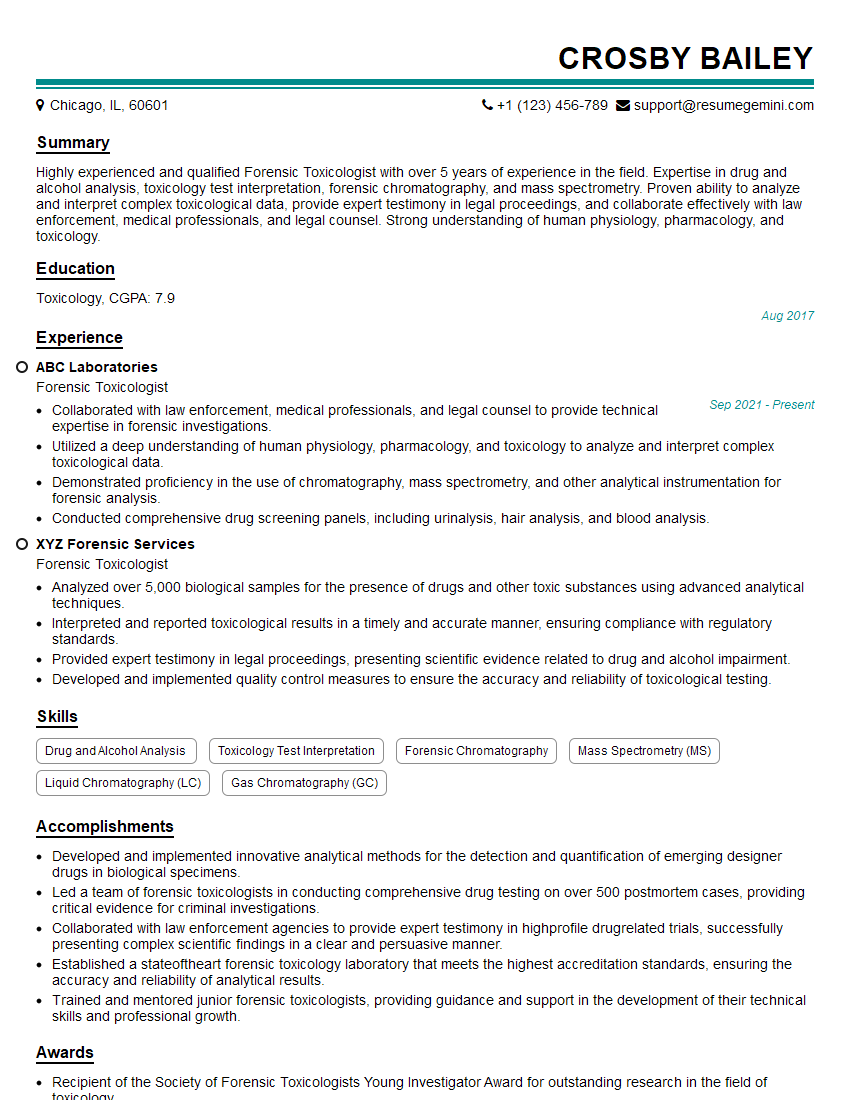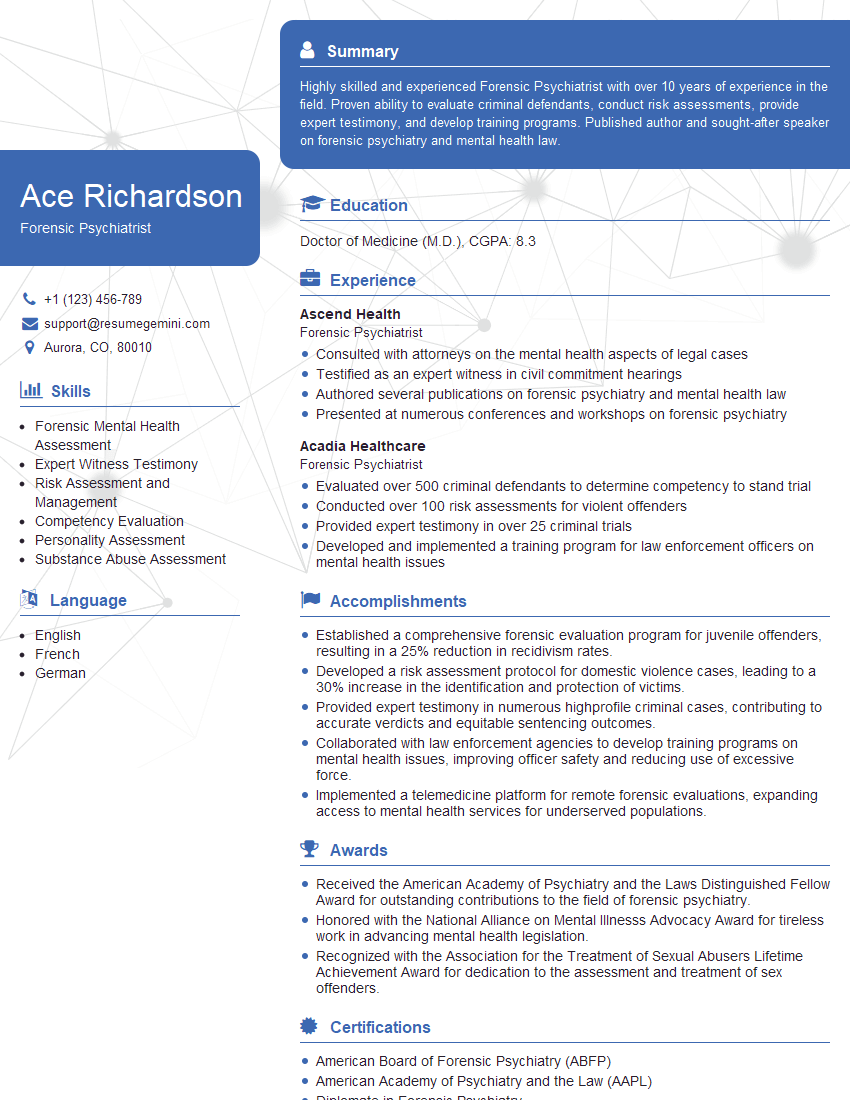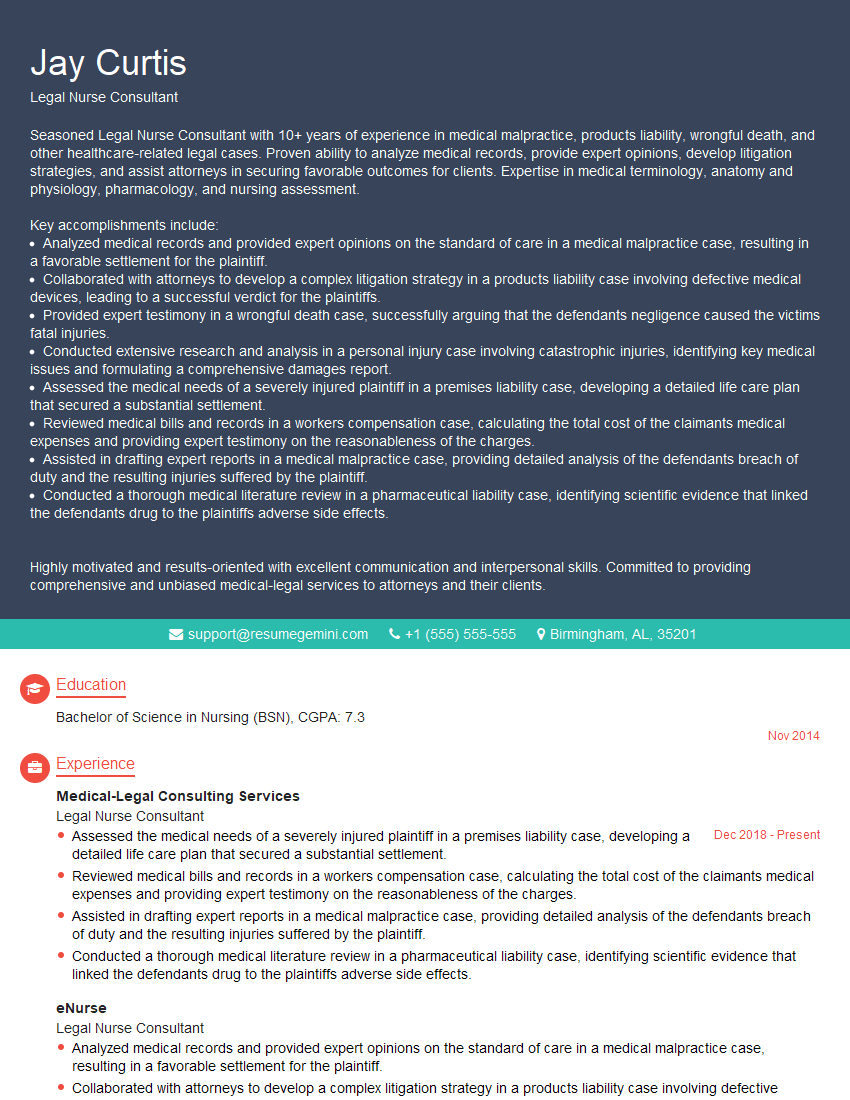Feeling uncertain about what to expect in your upcoming interview? We’ve got you covered! This blog highlights the most important Medical Jurisprudence interview questions and provides actionable advice to help you stand out as the ideal candidate. Let’s pave the way for your success.
Questions Asked in Medical Jurisprudence Interview
Q 1. Define medical jurisprudence and its relevance to healthcare.
Medical jurisprudence, also known as medical law, is the application of legal principles to the practice of medicine. It’s essentially the intersection of law and medicine, bridging the gap between healthcare professionals and the legal system. Its relevance to healthcare is paramount because it provides a framework for ethical and legal conduct, patient rights, and the resolution of disputes arising from medical practice. Without medical jurisprudence, the healthcare system would lack the necessary guidelines and processes to address malpractice, informed consent issues, confidentiality breaches, and other critical legal considerations.
Think of it as the rulebook for the medical profession, ensuring patient safety and accountability. It governs everything from doctor-patient relationships to the handling of medical records and the use of medical technology.
Q 2. Explain the concept of informed consent in a medical legal context.
Informed consent is a cornerstone of medical ethics and law. It means that a patient must be fully informed about a proposed medical treatment, including its benefits, risks, alternatives, and the potential consequences of refusing treatment, before giving permission for the procedure. This consent must be voluntary, without coercion or undue influence. The patient needs to understand the information provided to them sufficiently to make an informed decision.
For instance, before undergoing surgery, a patient should be informed about the surgical procedure itself, the anesthesia risks, potential complications, recovery time, and the likelihood of success. Failure to obtain proper informed consent can lead to legal repercussions, such as medical malpractice lawsuits.
- Capacity: The patient must possess the mental capacity to understand the information.
- Disclosure: The physician must provide all relevant information in a way the patient can understand.
- Comprehension: The patient must demonstrate an understanding of the information.
- Voluntariness: The decision must be made freely, without coercion.
Q 3. Describe the legal aspects of patient confidentiality and HIPAA.
Patient confidentiality is a fundamental ethical principle and legal obligation of healthcare providers. It mandates the protection of a patient’s personal health information from unauthorized access, use, or disclosure. In the United States, the Health Insurance Portability and Accountability Act of 1996 (HIPAA) sets stringent standards for protecting the privacy and security of Protected Health Information (PHI).
HIPAA establishes rules and regulations that cover the use, disclosure, and safeguarding of PHI, including medical records, billing information, and communication between healthcare providers. Violations of HIPAA can result in significant civil and criminal penalties. For example, a doctor who discusses a patient’s diagnosis with a friend violates HIPAA. Similarly, a hospital that experiences a data breach exposing PHI faces serious legal consequences.
Maintaining patient confidentiality is not just a legal requirement but also essential for building trust between patients and healthcare providers. Without it, patients would be hesitant to share sensitive information, potentially hindering their care.
Q 4. What are the key elements of medical malpractice?
Medical malpractice occurs when a healthcare professional deviates from the accepted standard of care, resulting in harm to the patient. This means that the healthcare professional’s actions (or lack thereof) fell below the level of care a reasonably prudent healthcare professional would have provided in a similar situation. Key elements include:
- Duty: A professional relationship existed between the healthcare provider and the patient.
- Breach of Duty: The healthcare provider failed to meet the accepted standard of care.
- Causation: The breach of duty directly caused the patient’s injury.
- Damages: The patient suffered actual harm or injury as a result.
For example, a surgeon leaving a surgical sponge inside a patient after an operation would be considered a breach of the standard of care, leading to potential malpractice if it caused harm.
Q 5. How does medical negligence differ from medical malpractice?
Medical negligence and medical malpractice are closely related but distinct concepts. Medical negligence is simply the failure to exercise the care that a reasonably prudent person would exercise in a similar situation. It’s a broader term that encompasses a wide range of actions or omissions. Medical malpractice, on the other hand, is a specific type of negligence that occurs within the context of a professional healthcare relationship and results in harm to the patient.
Essentially, all medical malpractice is medical negligence, but not all medical negligence constitutes medical malpractice. For example, a doctor forgetting to schedule a follow-up appointment might be considered medical negligence, but it may not rise to the level of malpractice unless it directly causes significant harm to the patient.
Q 6. Discuss the role of expert witnesses in medical legal cases.
Expert witnesses play a crucial role in medical legal cases. They are individuals with specialized knowledge and experience in a particular medical field who can provide testimony to the court. Their role is to help the judge or jury understand complex medical information and to offer opinions on whether the healthcare provider met the accepted standard of care.
Expert witnesses can review medical records, test results, and other evidence to provide an independent assessment of the case. Their testimony is often critical in determining the cause of a patient’s injury and whether medical malpractice occurred. The selection of a qualified and credible expert witness is crucial to the success of a medical legal case. They must be able to clearly communicate complex medical concepts to a lay audience.
Q 7. Explain the process of obtaining and interpreting medical records for legal purposes.
Obtaining and interpreting medical records for legal purposes requires a meticulous and legally sound approach. The process typically involves:
- Identifying Relevant Records: Determining which medical records are necessary to support the legal claim.
- Proper Authorization: Obtaining proper authorization from the patient to release their medical records. This often involves completing specific authorization forms that comply with HIPAA and other relevant regulations.
- Submitting Requests: Submitting formal requests for records to the healthcare providers or institutions that hold them. This usually involves specific forms and may require payment of fees.
- Review and Organization: Reviewing and organizing the received records to ensure completeness and accuracy. This can involve identifying missing records or inconsistencies.
- Interpretation: Interpreting the medical records requires a thorough understanding of medical terminology and the ability to discern the relevant information for the legal case. This may involve consultation with an expert witness.
It’s critical to ensure all legal requirements are met throughout the process to avoid potential legal issues and ensure the admissibility of the records in court. Improperly obtained records are inadmissible and can significantly weaken a case.
Q 8. What are the legal implications of end-of-life care decisions?
End-of-life care decisions carry significant legal implications, primarily revolving around patient autonomy and the right to refuse treatment. This includes the legal frameworks surrounding advance directives like living wills and durable powers of attorney for healthcare. These documents allow individuals to express their wishes regarding medical treatment should they become incapacitated. The legal implications also extend to the physician’s responsibility to respect these wishes, while balancing their ethical duty to preserve life.
For instance, a patient with a terminal illness and a living will refusing life-sustaining treatment cannot be legally forced to undergo those treatments. Conversely, a physician who ignores a valid advance directive could face legal repercussions. The legal landscape also encompasses discussions around assisted suicide and euthanasia, which are highly regulated and often prohibited except under very specific circumstances, varying considerably across jurisdictions. Navigating this area requires a thorough understanding of state and federal laws, and often consultation with legal counsel.
Consider the case of a patient with advanced dementia who previously executed a living will stating a refusal of artificial nutrition and hydration. If their family challenges the execution of this document, a court will need to weigh the patient’s capacity at the time of execution and the validity of the document to ensure patient autonomy is upheld.
Q 9. Describe different types of medical liability insurance.
Medical liability insurance protects healthcare professionals and facilities from financial losses resulting from medical malpractice lawsuits. Several types exist, each offering different levels of coverage and protection.
- Claims-Made Insurance: This covers only claims made during the policy period, regardless of when the incident occurred. It usually requires tail coverage to extend protection after the policy expires.
- Occurrence Insurance: This covers incidents that occur during the policy period, even if the claim is filed later. This provides broader, long-term protection.
- Tail Coverage: Purchased separately, this extends coverage for claims arising from incidents that occurred during a claims-made policy, but are filed after the policy expires.
- Professional Liability Insurance: This is the most common type, covering claims of negligence, errors in judgment, and breaches of duty of care.
- General Liability Insurance: This covers non-professional liability, such as slip-and-fall accidents on the premises.
Choosing the right type depends on the individual’s or facility’s risk profile and financial resources. For example, a young physician starting their practice might find occurrence insurance a more suitable long-term investment, while an established practice might opt for claims-made with tail coverage to manage costs.
Q 10. How does the standard of care vary across medical specialties?
The standard of care in medical malpractice cases is the level of skill and care that a reasonably prudent healthcare professional in the same specialty would provide under similar circumstances. This means the standard varies significantly across medical specialties. A neurosurgeon, for example, is held to a different standard than a family physician.
A neurosurgeon’s standard of care will reflect the specialized knowledge, skills, and techniques expected of a board-certified neurosurgeon. This includes the use of advanced imaging, surgical techniques, and post-operative care protocols relevant to their specialization. A family physician, on the other hand, will be held to the standard expected of a reasonably prudent family physician, which may not involve the same level of specialized expertise in neurosurgery. The standard also varies based on geographic location and access to resources; a rural physician may face a different standard of care than one in an urban medical center with access to advanced technology and specialists.
Expert witnesses are crucial in determining the applicable standard of care in medical malpractice cases, providing testimony on the relevant specialty’s practices and expectations. Failure to meet this standard, coupled with causation and damages, constitutes medical negligence.
Q 11. Outline the process of a medical malpractice lawsuit.
A medical malpractice lawsuit typically follows these steps:
- Investigation and Consultation: The potential plaintiff seeks legal counsel and gathers evidence to support a claim of negligence. This often includes obtaining medical records and consulting with medical experts.
- Filing a Complaint: The plaintiff’s attorney files a formal complaint against the healthcare provider(s) with the appropriate court.
- Discovery: Both sides exchange information, including medical records, depositions, and interrogatories, to gather evidence and prepare for trial.
- Motion Practice: Either side may file motions to dismiss the case or for summary judgment based on legal arguments.
- Settlement Negotiations: Most malpractice cases are settled outside of court to avoid the expense and uncertainty of a trial.
- Trial: If settlement fails, the case proceeds to trial, where a jury or judge determines liability and damages.
- Appeal: The losing party may appeal the court’s decision to a higher court.
Each step involves complex legal procedures and requires the expertise of legal professionals. The process can be lengthy and expensive, often lasting several years.
Q 12. Discuss the legal implications of medical errors.
Medical errors, even unintentional ones, can have significant legal implications. If an error results in harm to a patient, it may lead to a medical malpractice lawsuit. The legal implications hinge on whether the error constitutes negligence – a breach of the standard of care that caused harm.
For instance, a surgeon accidentally leaving a surgical sponge inside a patient’s abdomen is a clear example of negligence that could result in serious legal consequences. The severity of the legal implications depends on several factors, including the nature and severity of the error, the resulting harm, the presence of mitigating circumstances, and the jurisdiction’s laws.
Hospitals and healthcare systems also face legal implications. They might face vicarious liability for the actions of their employees, even if the individual healthcare provider is also held responsible. This highlights the importance of robust risk management protocols and incident reporting systems within healthcare organizations to minimize the chances of malpractice and legal ramifications. Beyond legal implications, medical errors can lead to loss of professional reputation and licensing issues.
Q 13. Explain the concept of causation in medical malpractice cases.
Causation is a crucial element in medical malpractice cases. To prove negligence, a plaintiff must demonstrate that the healthcare provider’s breach of the standard of care directly caused the patient’s injury. It’s not enough to show that the provider acted negligently; the plaintiff must prove a direct causal link between the negligence and the harm suffered.
This often requires expert medical testimony to establish the causal relationship. For example, if a patient develops an infection after surgery and the plaintiff alleges the infection resulted from the surgeon’s failure to follow sterile technique, expert testimony would be needed to establish that the failure to follow sterile technique directly caused the infection, as opposed to other potential causes. The ‘but-for’ test is frequently applied: Would the injury have occurred ‘but for’ the physician’s negligence? If the answer is no, causation is established.
Establishing causation can be challenging, particularly in cases with multiple potential contributing factors. Expert testimony plays a crucial role in navigating the complexities of medical causation, often requiring detailed analysis of medical records, testing results, and consideration of alternative explanations for the patient’s injury.
Q 14. What are the ethical considerations related to medical research?
Ethical considerations in medical research are paramount, guided by principles like beneficence (maximizing benefits), non-maleficence (minimizing harm), respect for persons (autonomy and informed consent), and justice (fair distribution of benefits and burdens). These principles are embodied in guidelines such as the Declaration of Helsinki and institutional review board (IRB) processes.
Key ethical considerations include:
- Informed Consent: Participants must be fully informed of the study’s purpose, procedures, risks, and benefits before providing voluntary consent. This requires clear, understandable language and the ability to withdraw at any time.
- Vulnerable Populations: Special protections are needed for vulnerable populations like children, pregnant women, prisoners, and individuals with cognitive impairments, ensuring their autonomy and minimizing exploitation.
- Data Privacy and Confidentiality: Protecting the privacy and confidentiality of participants’ data is essential. Researchers must adhere to strict data security protocols and anonymization techniques.
- Conflicts of Interest: Researchers must disclose and manage any potential conflicts of interest that could bias the study’s design, conduct, or interpretation.
- Scientific Validity: Research must be scientifically sound, well-designed, and appropriately analyzed to justify the risks to participants.
IRBs review research proposals to ensure they adhere to ethical guidelines and protect the rights and welfare of participants. Failure to address these ethical considerations can lead to severe consequences, including legal repercussions, damage to professional reputation, and the retraction of published research.
Q 15. How do you handle conflicting medical opinions in a legal setting?
Conflicting medical opinions are common in legal settings. My approach involves a systematic review of all medical evidence, including considering the qualifications, experience, and methodology of each expert. I look for inconsistencies in reasoning, data interpretation, or adherence to established medical standards. Instead of simply choosing one side, I focus on identifying the areas of agreement and disagreement, and then explaining these differences clearly and concisely, highlighting the strengths and weaknesses of each opinion. This might involve a detailed comparison of diagnostic methods used, the supporting literature cited, and the overall plausibility of each conclusion within the context of the case. Ultimately, I aim to present a neutral, objective analysis that allows the court to reach its own informed decision.
For example, in a case involving a traumatic brain injury, one expert might emphasize the patient’s cognitive deficits as evidence of permanent damage, while another might focus on the potential for neurological recovery. My role would be to thoroughly examine the neuropsychological testing data, imaging reports, and treatment records, outlining the supporting evidence and discrepancies between the two opinions to the court, leaving the final determination of causation and severity to the judge or jury.
Career Expert Tips:
- Ace those interviews! Prepare effectively by reviewing the Top 50 Most Common Interview Questions on ResumeGemini.
- Navigate your job search with confidence! Explore a wide range of Career Tips on ResumeGemini. Learn about common challenges and recommendations to overcome them.
- Craft the perfect resume! Master the Art of Resume Writing with ResumeGemini’s guide. Showcase your unique qualifications and achievements effectively.
- Don’t miss out on holiday savings! Build your dream resume with ResumeGemini’s ATS optimized templates.
Q 16. Describe your experience with analyzing medical records for legal cases.
Analyzing medical records is a core component of my work. My experience encompasses a wide range of cases, from personal injury claims to medical malpractice suits and criminal investigations. My approach involves a thorough review of the entire medical record, paying close attention to chronology, consistency, and completeness. I look for patterns, discrepancies, and missing information, verifying details against other records and consulting relevant medical literature when needed. I pay particular attention to the accuracy and reliability of diagnostic tests, treatment plans, and prognosis. I also consider the context of the records, including the patient’s medical history, lifestyle, and social circumstances.
For instance, in a wrongful death case, I might meticulously examine the deceased’s medical history to identify any pre-existing conditions that might have contributed to their death, comparing this information with the immediate cause of death documented by the attending physician. I would cross-reference this data with hospital records, emergency room notes, and autopsy reports to form a comprehensive understanding of the sequence of events and the role of any alleged negligence.
Q 17. How familiar are you with relevant state and federal healthcare laws?
I possess a strong understanding of relevant state and federal healthcare laws, including HIPAA (Health Insurance Portability and Accountability Act), EMTALA (Emergency Medical Treatment and Active Labor Act), and various state medical malpractice statutes. My knowledge extends to informed consent regulations, patient privacy laws, and reporting requirements for certain medical events. I regularly stay updated on changes and amendments to these laws through continuing legal education and professional journals. This ensures I can accurately assess compliance with legal standards in all cases I handle. The specific laws relevant to a case, of course, will depend on the jurisdiction.
For instance, understanding HIPAA is crucial in protecting patient privacy while ensuring that only legally permissible information is disclosed during litigation. Similarly, knowledge of EMTALA ensures that I can evaluate whether a hospital acted appropriately in providing emergency medical treatment. Understanding state-specific malpractice laws is critical to determining the standard of care and whether any breaches have occurred.
Q 18. What is your understanding of the Daubert Standard?
The Daubert Standard, stemming from the Supreme Court case *Daubert v. Merrell Dow Pharmaceuticals*, establishes criteria for admitting scientific evidence in federal courts. It emphasizes the reliability and validity of scientific methodologies used to generate expert testimony. Key factors considered include whether the theory or technique can be and has been tested; whether it has been subjected to peer review and publication; its known or potential error rate; and the existence and maintenance of standards controlling its operation. This standard helps ensure that only scientifically sound evidence is presented to the court, preventing unreliable or speculative testimony from influencing legal decisions. Essentially, it’s a gatekeeping function to maintain the integrity of the judicial process.
A hypothetical example would be a case involving a novel diagnostic test. Before admitting testimony on its results, the court would assess whether the test has been rigorously validated through peer-reviewed studies, if its accuracy has been determined, and if there are established protocols for its use.
Q 19. Explain the differences between civil and criminal medical legal cases.
Civil and criminal medical legal cases differ significantly in their objectives and burdens of proof. In civil cases (e.g., medical malpractice, personal injury), the plaintiff (the injured party) must prove negligence or breach of duty by a preponderance of the evidence (more likely than not). Damages are typically monetary compensation for the harm suffered. Criminal cases (e.g., manslaughter, medical homicide), on the other hand, involve allegations of criminal wrongdoing, requiring the prosecution to prove guilt beyond a reasonable doubt. The potential penalties are significantly more severe, ranging from fines to imprisonment. The standard of proof is considerably higher in criminal cases.
For instance, a doctor’s negligent act leading to patient injury would be a civil matter, while the same action resulting in the patient’s death might be prosecuted as a criminal offense. In the civil case, focus would be on the doctor’s adherence to the standard of care and the resulting damages to the patient. In the criminal case, the focus would shift to intent, recklessness, or gross negligence that led to the death.
Q 20. What is your experience working with expert witnesses?
I have extensive experience collaborating with expert witnesses from various medical specialties. My role often involves assisting attorneys in selecting appropriate experts, reviewing their reports for clarity and accuracy, preparing them for depositions and trial testimony, and ensuring their testimony aligns with the legal strategy. I understand the importance of effective communication and collaboration between legal counsel and medical experts to present a compelling and persuasive case. This includes helping experts translate complex medical concepts into readily understandable language for a lay audience, ensuring the reports are both scientifically sound and legally relevant.
I have worked with experts such as cardiologists, neurologists, and orthopedic surgeons, coordinating their findings and ensuring consistency across multiple medical disciplines when necessary. Effective communication and teamwork are vital to building a strong, defensible case.
Q 21. How do you approach a case involving complex medical terminology?
When dealing with complex medical terminology, my approach is two-pronged. First, I utilize my in-depth medical knowledge to understand the underlying concepts. Second, I prioritize clear and concise communication, avoiding unnecessary jargon. I translate complex medical terms and concepts into plain language for the legal professionals and the court. I create explanatory materials, such as diagrams or timelines, to help visualize complex medical processes. I also consult with other medical experts when necessary to ensure accurate understanding and interpretation of the medical information. Transparency and clear explanation are key to making complex information accessible and understandable.
For example, if dealing with a case involving a rare genetic disorder, I’d research the condition thoroughly to understand its pathogenesis, clinical manifestations, and diagnostic criteria. Then, I would explain the information in a simplified manner to the legal team, using analogies and visual aids to clarify any complex aspects.
Q 22. Describe a challenging medical legal case you’ve worked on and how you overcame the challenges.
One of the most challenging cases involved a wrongful death lawsuit concerning a delayed diagnosis of a rare form of leukemia. The plaintiff alleged that the treating hematologist’s negligence directly led to the patient’s demise. The challenge lay in establishing a clear causal link between the alleged delay in diagnosis and the patient’s death, given the aggressive nature of the leukemia. The patient’s medical history was complex, involving multiple consultations and tests from different facilities.
To overcome this, we meticulously reviewed all available medical records, including pathology reports, imaging studies, and consultation notes. We engaged expert hematology witnesses who could explain the progression of the disease in clear, understandable terms for the jury. We created a timeline meticulously detailing every event, highlighting the missed opportunities for early diagnosis and treatment. This detailed timeline, combined with the expert testimony, effectively demonstrated the causal link and the degree of negligence, ultimately leading to a favorable settlement for the defense.
Q 23. What is your familiarity with different types of forensic evidence?
My familiarity with forensic evidence encompasses a broad range, including:
- Biological evidence: DNA analysis from blood, saliva, semen, hair, etc., used for identification and linking individuals to crime scenes.
- Trace evidence: Microscopic materials such as fibers, paint chips, glass fragments, and gunshot residue, useful in reconstructing events.
- Digital evidence: Data from computers, mobile phones, and other electronic devices, crucial in cybercrimes and other investigations.
- Chemical evidence: Analysis of substances like drugs, toxins, and accelerants, often vital in toxicology and arson cases.
- Ballistics evidence: Analysis of firearms, bullets, and cartridge cases, determining the weapon used and the trajectory of projectiles.
- Impression evidence: Fingerprints, footprints, tire tracks, and toolmarks, providing valuable physical evidence.
Understanding the chain of custody and proper handling procedures for all these evidence types is paramount to ensuring its admissibility in court.
Q 24. Explain the concept of proximate cause in a medical negligence case.
In medical negligence cases, proximate cause is the direct causal link between the physician’s negligence and the patient’s injury. It means the injury wouldn’t have occurred *but for* the physician’s breach of the standard of care. It’s not enough to show negligence; one must prove that this negligence directly resulted in the harm.
For example, if a doctor fails to diagnose a fracture, leading to delayed treatment and increased pain and disability, the failure to diagnose (negligence) is the proximate cause of the increased suffering (injury). However, if the patient would have suffered the same outcome regardless of the delayed diagnosis, proximate cause cannot be established. Establishing proximate cause often requires expert medical testimony to demonstrate the causal pathway between the breach of duty and the harm sustained.
Q 25. How would you explain complex medical information to a non-medical audience?
Explaining complex medical information to a non-medical audience requires clear, concise communication, avoiding jargon and technical terms. I use analogies and relatable examples to simplify intricate concepts. For example, when discussing a heart condition, I might compare the heart to a pump, explaining how blockages can impede its function, similar to a clogged pipe.
Visual aids like diagrams, charts, and even short videos can greatly enhance understanding. I focus on explaining the ‘why’ behind the medical information, linking it to the patient’s overall well-being and treatment plan. Active listening and checking for understanding throughout the explanation are critical to ensure effective communication.
Q 26. What resources do you utilize to stay updated on changes in medical jurisprudence?
Staying updated in medical jurisprudence requires a multi-faceted approach. I regularly consult legal journals and databases such as Westlaw and LexisNexis for case law updates and legal analysis. I also subscribe to professional medical journals and attend continuing medical education (CME) courses that address legal and ethical aspects of medicine. Membership in professional organizations like the American College of Legal Medicine provides access to resources, conferences, and networking opportunities to remain current on the latest developments and best practices.
Q 27. Describe your understanding of the legal implications of physician-patient communication.
Physician-patient communication carries significant legal implications, primarily concerning patient confidentiality and informed consent. The legal principle of confidentiality, protected by HIPAA in the US, necessitates that physicians maintain the privacy of patient information. Disclosure without consent, except under specific legal exceptions, can lead to legal action.
Informed consent requires physicians to explain medical procedures, risks, benefits, and alternatives to their patients in terms they can understand. Failure to obtain informed consent before a procedure could lead to a claim of battery or negligence. Adequate documentation of the communication, including the patient’s understanding and consent, is essential for legal protection.
Q 28. How would you handle a situation where you have a conflict of interest in a medical legal case?
A conflict of interest arises when a professional’s personal interests could compromise their objectivity in a case. If such a conflict arises, my first step is to recognize and disclose it immediately to all involved parties—the client, opposing counsel, and any relevant oversight bodies. I would then carefully assess whether the conflict is significant enough to require recusal. If the conflict cannot be managed effectively, I would withdraw from the case to maintain ethical integrity and avoid any appearance of impropriety. Transparency and proactive conflict management are crucial in upholding professional standards.
Key Topics to Learn for Your Medical Jurisprudence Interview
Preparing for a Medical Jurisprudence interview requires a comprehensive understanding of its multifaceted nature. Success hinges on not only theoretical knowledge but also the ability to apply this knowledge to real-world scenarios. The following key areas will significantly enhance your preparedness:
- Medical Ethics and Law: Explore the intersection of ethical principles and legal frameworks in medical practice. Consider case studies involving informed consent, patient confidentiality, and end-of-life care.
- Medical Negligence and Malpractice: Understand the legal definitions and elements of negligence and malpractice. Analyze scenarios to determine liability and potential legal consequences. Develop your skills in evaluating the standard of care.
- Forensic Medicine: Familiarize yourself with the application of medical knowledge in legal settings. This includes understanding autopsy procedures, forensic pathology, and the interpretation of medical evidence in court.
- Evidence and Testimony: Learn how medical evidence is presented in legal proceedings. Practice structuring clear and concise expert testimony, understanding the importance of objectivity and accuracy.
- Specific Legal Statutes and Regulations: Research relevant laws and regulations pertaining to medical practice in your jurisdiction. Understand the implications of these laws on clinical decision-making and legal responsibilities.
- Problem-Solving and Case Analysis: Develop your ability to analyze complex medical-legal scenarios, identify key issues, and propose solutions based on ethical principles and legal precedents. Practice breaking down complex problems into manageable components.
Next Steps: Unlock Your Career Potential
Mastering Medical Jurisprudence is crucial for career advancement in healthcare and related fields. A strong understanding of these principles demonstrates your commitment to ethical practice and legal compliance, making you a highly desirable candidate. To maximize your job prospects, it’s essential to present your qualifications effectively. Creating an Applicant Tracking System (ATS)-friendly resume is key to getting your application noticed. We strongly recommend utilizing ResumeGemini to build a powerful and professional resume tailored to the specific requirements of Medical Jurisprudence roles. ResumeGemini provides examples of resumes specifically designed for this field, ensuring your application stands out from the competition. Take the next step towards your dream career today!
Explore more articles
Users Rating of Our Blogs
Share Your Experience
We value your feedback! Please rate our content and share your thoughts (optional).
What Readers Say About Our Blog
Hi, I have something for you and recorded a quick Loom video to show the kind of value I can bring to you.
Even if we don’t work together, I’m confident you’ll take away something valuable and learn a few new ideas.
Here’s the link: https://bit.ly/loom-video-daniel
Would love your thoughts after watching!
– Daniel
This was kind of a unique content I found around the specialized skills. Very helpful questions and good detailed answers.
Very Helpful blog, thank you Interviewgemini team.
